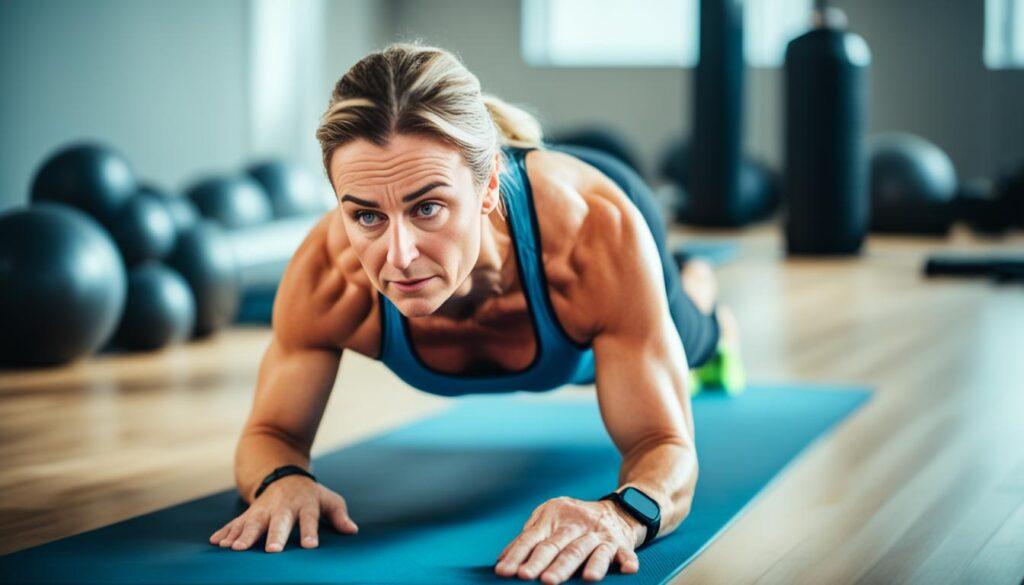According to functional fitness experts, traditional ab exercises like crunches and sit-ups may not be the most effective way to build functional core strength and stability. To truly strengthen your core for everyday movements, you need to focus on functional ab exercises that engage your entire core, including the rectus abdominis, transverse abdominis, external obliques, and internal obliques. These exercises not only improve core strength but also assist in injury prevention and enhance overall health and quality of life. Let’s explore some of the best functional ab exercises that target different movement patterns and enhance core stability.
Key Takeaways:
- Functional ab exercises are essential for strengthening your core and improving core stability for everyday movements.
- Engaging your entire core, including the rectus abdominis, transverse abdominis, external obliques, and internal obliques, is crucial for optimal results.
- Functional ab exercises target different movement patterns, such as squats, deadlifts, overhead press, rotational movements, anti-rotation exercises, and carrying exercises.
- By incorporating these exercises into your routine, you can build a strong and stable core that supports your everyday activities and reduces the risk of injuries.
- Functional ab exercises not only benefit athletes but also anyone looking to improve their overall strength and enhance their quality of life.
The Importance of Functional Core Training
Functional core training goes beyond aesthetics and focuses on building overall core strength and stability. When it comes to core training, it’s not just about looking good; it’s about feeling good and performing better in your daily activities and sports.
A strong and stable core is essential for proper movement mechanics and injury prevention. Research has shown that core stability plays a crucial role in preventing lower extremity injuries, such as ACL injuries. By developing a strong core, you can reduce the risk of these injuries and improve your overall physical performance.
Functional core training also enhances balance, proprioception, and muscle thickness. Proprioception, or the awareness of your body’s position in space, is essential for athletic performance and injury prevention. When your core is stable and strong, it helps improve your balance and coordination during dynamic movements.
Additionally, functional core training increases muscle thickness, leading to improved muscle function and overall strength. By engaging your core in functional movements, you target and activate the deep abdominal muscles, including the transverse abdominis, which contributes to greater muscle thickness and stability.
Functional core training not only improves core strength but also enhances overall body coordination, power, and agility.
Incorporating functional ab exercises into your workout routine is key to reaping the benefits of functional core training. By focusing on exercises that engage your entire core and mimic everyday movements, you can build a strong foundation that supports your body’s functionality and performance.
The True Role of Core Training
Unlike the pursuit of purely aesthetic goals, functional core training prioritizes building a solid foundation that translates into better movement patterns and injury prevention. Aesthetic-focused training may prioritize exercises that isolate superficial muscles, such as crunches and sit-ups, but functional core training targets the deeper core muscles responsible for stability and control.
By incorporating functional ab exercises into your routine, you not only build core strength but also improve your ability to perform everyday activities with ease and efficiency. These exercises train your core to work in harmony with your body, ensuring optimal stability and control during movements like squats, deadlifts, and overhead presses.
Functional core training is a valuable addition to any fitness routine, whether you’re an athlete looking to enhance performance or someone aiming to move with confidence and reduce the risk of injuries in daily life.
Key Functional Ab Exercises for Core Strength
When it comes to strengthening your core and improving core stability, there are several key functional ab exercises that can help you achieve your goals. By targeting different muscles in the core and challenging your core strength and stability in unique ways, these exercises are a valuable addition to any fitness routine. Incorporate these exercises into your workout routine and build a strong and stable core that supports your everyday movements.
Hollow Hold
One of the fundamental exercises for core strength is the hollow hold. This exercise involves lying flat on your back, lifting your shoulders and legs off the ground, and hollowing out your core by pressing your lower back into the floor. Hold this position for a set amount of time or until failure. The hollow hold engages your rectus abdominis, transverse abdominis, and obliques, helping to develop a strong and stable core.
Hollow Rock
Similar to the hollow hold, the hollow rock is a dynamic variation that adds an element of movement to the exercise. Begin in the hollow hold position and rock back and forth, maintaining the hollow position throughout the movement. This exercise challenges your core stability and further activates the muscles in your core.
Tuck-Up
The tuck-up is an exercise that targets both your upper and lower abs. Start by lying on your back with your legs straight and arms extended overhead. Simultaneously lift your upper body and legs, bringing your knees toward your chest and reaching for your shins. Lower back down with control and repeat. The tuck-up helps to strengthen your entire core and improve overall core stability.
V-Up
The V-up is another exercise that targets your upper and lower abs. Begin by lying flat on your back with your legs straight and arms extended overhead. Simultaneously lift your upper body and legs, reaching towards your toes and forming a V shape with your body. Lower back down with control and repeat. The V-up challenges your core strength and stability, helping you develop a strong and defined midsection.
Tuck Hold from Bar
The tuck hold from the bar is an exercise that targets your entire core, including your upper abs, lower abs, and obliques. Hang from a pull-up bar with your hands shoulder-width apart and lift your knees towards your chest, tucking them in as close as possible. Hold this position for a set amount of time or until failure. The tuck hold from the bar improves your grip strength and core stability.
L-Sit Hold from Bar
The L-sit hold from the bar is an advanced exercise that challenges your core strength and stability. Hang from a pull-up bar with your hands shoulder-width apart and lift your legs straight out in front of you, forming an L shape with your body. Hold this position for a set amount of time or until failure. The L-sit hold from the bar targets your entire core, especially your lower abs and hip flexors.
Plank Variations
Planks are incredibly effective for strengthening your core and improving core stability. There are several variations you can incorporate into your routine to target different areas of your core and challenge your stability. Some popular plank variations include side planks, elevated planks, and plank leg lifts. These exercises engage your entire core, including your abs, obliques, and lower back, helping you develop a strong and stable core.
 By including these key functional ab exercises in your workout routine, you can strengthen your core, improve core stability, and enhance your overall fitness. Challenge yourself with these exercises and experience the benefits of a strong and stable core that supports you in your everyday movements.
By including these key functional ab exercises in your workout routine, you can strengthen your core, improve core stability, and enhance your overall fitness. Challenge yourself with these exercises and experience the benefits of a strong and stable core that supports you in your everyday movements.
Functional Ab Exercises that Mimic Daily Activities
Functional ab exercises go beyond just building core strength. They are designed to simulate the movements you encounter in daily life, helping you develop functional movement patterns and improve core stability. By incorporating exercises like farmer’s walks, chopping and lifting movements, dead bug, superman, and back extensions into your routine, you can strengthen the muscles necessary for everyday movements and enhance your overall physical performance.
Let’s take a closer look at these functional ab exercises:
- Farmer’s Walks: This exercise involves carrying heavy weights in each hand and walking for a specific distance or duration. It mimics the action of carrying heavy loads, such as groceries or luggage, and helps strengthen the muscles in your core, shoulders, and arms.
- Chopping and Lifting Movements: These exercises involve rotational movements combined with lifting or chopping motions. They simulate actions like picking up objects from the ground, reaching overhead to grab something, or chopping wood. By engaging your core and upper body muscles, these exercises improve functional strength and stability.
- Dead Bug: The dead bug exercise mimics the movement pattern of alternating arm and leg extensions, similar to the way insects move. It challenges your core stability and helps improve coordination and control.
- Superman: This exercise involves lying face down and lifting your arms and legs off the ground to resemble the flying position of Superman. It targets the muscles in your lower back, glutes, and hamstrings, helping to improve posterior chain strength and stability.
- Back Extensions: Back extensions are performed by lying face down and lifting your upper body off the ground. This exercise targets the erector spinae muscles, helping to strengthen your lower back and improve posture.
By incorporating these functional ab exercises into your routine, you can improve your core stability, strengthen the muscles necessary for everyday movements, and enhance your overall physical performance. Remember to perform these exercises with proper form and gradually increase the intensity as your core strength improves.
Incorporating Functional Core Exercises into Your Routine
To fully benefit from functional core exercises, it’s important to incorporate them into your workout routine properly. Functional fitness training focuses on improving your ability to perform everyday activities, so it’s crucial to incorporate movement patterns that simulate these activities. Additionally, using progressive overload and adaptive resistance principles can ensure that you continue to see progress in your core strength and stability. By following these guidelines, you can effectively incorporate functional ab exercises into your routine and reap the benefits for your core and overall fitness.
Movement Patterns:
When incorporating functional core exercises into your routine, it’s essential to focus on movement patterns that mimic the activities you perform in your daily life. This helps improve your core strength and stability in context-specific ways. For example, if you frequently lift heavy objects, exercises like deadlifts or farmer’s walks can simulate those movements and train your core accordingly. By replicating the movement patterns you encounter regularly, you enhance the functional strength of your core.
Progressive Overload:
Progressive overload is the principle of gradually increasing the demands placed on your muscles to stimulate growth and adaptation. This principle applies to functional core exercises as well. As your core strength improves, you should progressively challenge yourself by increasing the difficulty, duration, or resistance of the exercises. For instance, you can add weight to your planks or progress from a hollow hold to a hollow rock. This progression ensures that your core continuously adapts and strengthens over time.
Adaptive Resistance:
Adaptive resistance is another important principle to consider when incorporating functional core exercises into your routine. It involves using equipment or techniques that provide variable resistance throughout the exercise’s range of motion. This helps engage your core muscles more effectively and stimulates greater muscle activation. For example, performing tuck holds from a bar or L-sit holds from a bar challenges your core stability using your body weight as adaptive resistance.
By following these guidelines of incorporating movement patterns, progressive overload, and adaptive resistance, you can create an effective and well-rounded functional core training routine. This will enable you to strengthen your core muscles, enhance core stability, and improve your overall fitness and performance in daily activities.
| Exercise | Description |
|---|---|
| Hollow Hold | A static exercise where you maintain a hollow body position by lifting your shoulders and legs off the ground while engaging your core. |
| Hollow Rock | A dynamic exercise where you rock back and forth while maintaining a hollow body position. |
| Tuck-Up | A dynamic exercise where you curl up into a tuck position by engaging your core and bringing your knees towards your chest. |
| V-Up | A dynamic exercise where you lift your legs and upper body simultaneously, forming a V shape while engaging your core. |
| Tuck Hold from Bar | A static exercise where you hang from a bar with your knees tucked up towards your chest, engaging your core and upper body. |
| L-Sit Hold from Bar | A static exercise where you sit on parallel bars or supports, lifting your legs in an L shape while engaging your core. |
| Plank Variations | Various static exercises where you maintain a plank position, engaging your core and stabilizing your body. |
Benefits of Functional Core Training
Functional core training offers numerous benefits beyond core strength. These exercises transfer well to both sport and everyday life, improving your balance and stability for dynamic movements.
By incorporating functional core exercises into your routine, you can:
- Enhance your strength training: Functional core training helps you develop the necessary core strength and stability for movements like squats and deadlifts, enabling you to lift heavier weights and improve overall performance.
- Improve sports performance: Having a strong and stable core enhances your ability to move efficiently during sports activities, allowing you to perform at your peak and reducing the risk of injury.
- Transfer to everyday life: The movement patterns in functional core exercises closely resemble those used in daily activities like lifting objects, reaching, and maintaining good posture. By training your core in a functional way, you can improve your ability to perform these tasks with ease and reduce the risk of strain or injury.
- Enhance balance and stability: Functional core training challenges your stability and proprioception, enhancing your ability to maintain balance during dynamic movements and preventing falls or other balance-related accidents.
- Develop a resilient core: Incorporating a variety of movement patterns in your functional core training ensures that your core muscles are trained in different planes of motion, making them adaptable and resilient to various activities or sports you engage in.
With all these benefits, it’s clear that functional core training is a valuable addition to any fitness routine. Whether you’re an athlete looking to improve sports performance or simply want to move with ease in your daily life, incorporating functional core exercises can help you achieve your goals.
Conclusion
Functional ab exercises play a vital role in strengthening your core and improving your core stability for everyday movements. By incorporating these exercises into your routine, you can enhance your overall strength, prevent injuries, and improve your quality of life.
Whether you’re an athlete looking to improve performance or simply want to move with ease in your daily activities, functional ab exercises are a valuable addition to any fitness routine. They target the muscles in your core, including the rectus abdominis, transverse abdominis, external obliques, and internal obliques, ensuring a comprehensive workout for a strong and functional core.
By engaging in functional ab exercises, you can better support your body during activities such as squats, deadlifts, overhead presses, and rotational movements. Additionally, incorporating anti-rotation exercises and carrying exercises helps to improve core stability and properly engage your core muscles, leading to improved performance in various daily tasks and sports.
So, don’t wait any longer! Start incorporating functional ab exercises into your fitness routine today and experience the benefits of a strong and functional core. Your overall strength, stability, and quality of life will thank you!








